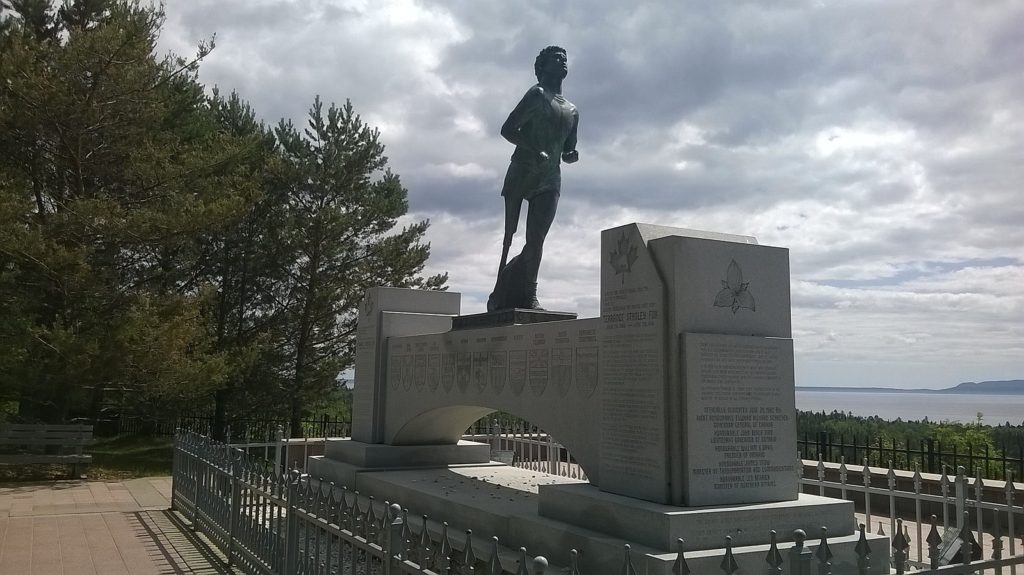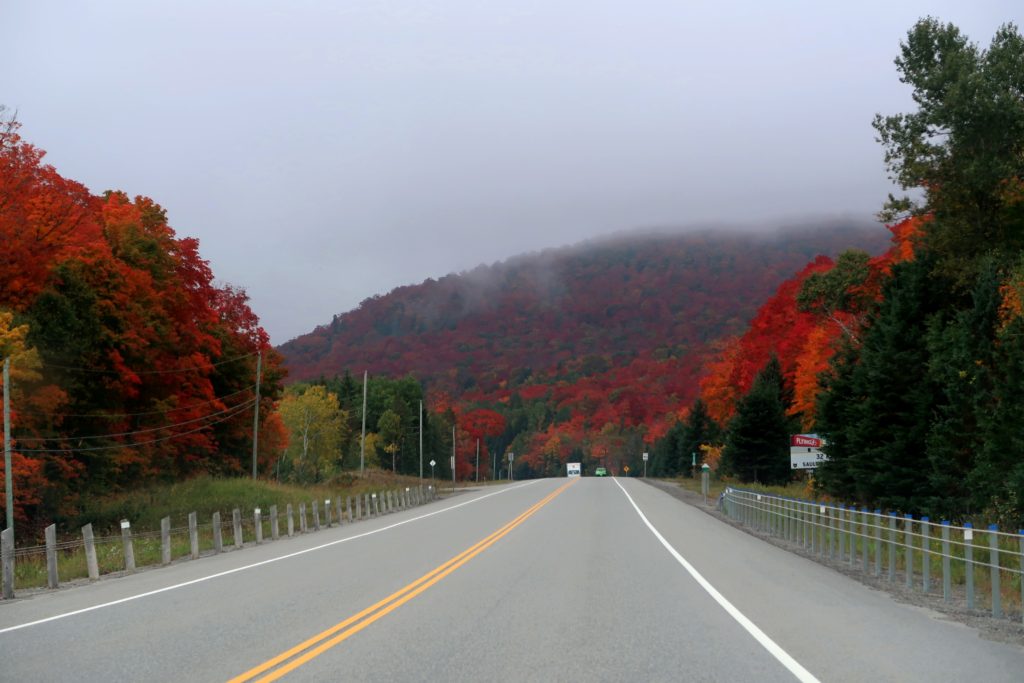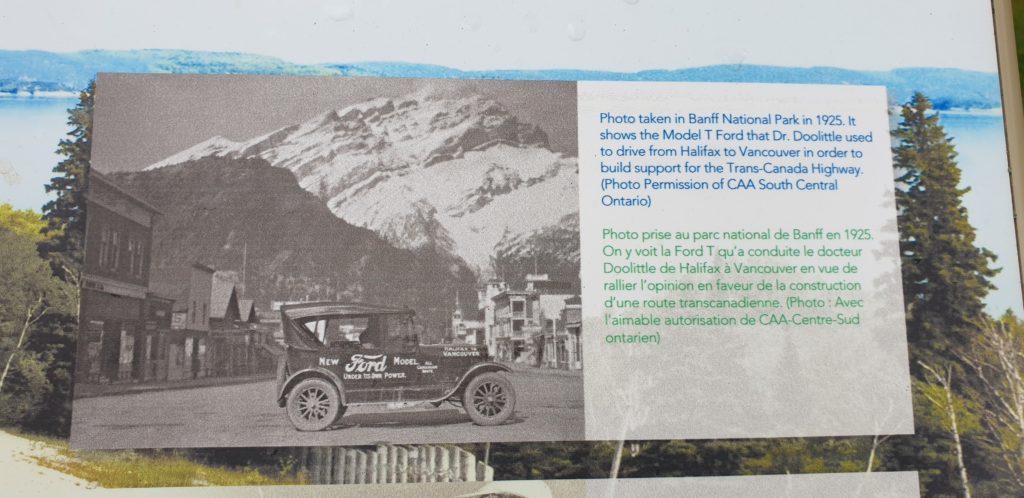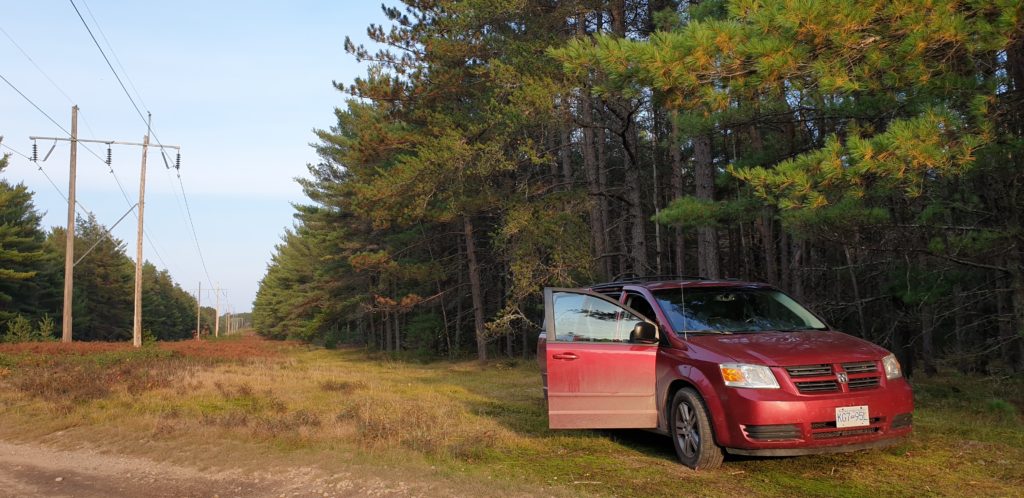We left Winnipeg early in the morning, grabbing another venti Starbucks coffee to share and beginning the long eight hour drive to Thunder Bay. We crossed the border between Manitoba and Ontario and shortly received a warm welcome to the province, with a driver behind me furiously waving his arms and giving us the finger (we were behind a slow truck, which was over-taking a slightly slower truck, and waiting for it to pass so we could too). In Ontario, the speed limit dropped from 100 to 90 km/h, but most people seemed to think it had increased to 120 km/h, and some drivers relished the challenge of overtaking with restricted visibility. It was certainly an exciting start to the drive!
We had what was probably our worst evening of the trip at Thunder Bay. We arrived just as it was getting dark, and awkwardly made our dinner at a picnic table in a park where a school sports game was being played nearby. The free campsite I’d researched seemed a bit dodgy to us, and we deliberated over another couple of spots before we found a place where we were comfortable. After a very long day of driving, it wasn’t quite what we wanted to be doing!
We visited the Terry Fox memorial just outside of Thunder Bay early the next morning. We had heard of him before, but it was incredibly humbling to visit the memorial and remember his story once more. Terry had lost his leg to bone cancer when he was 18, and aimed to raise money for cancer by running across the country in his “Marathon of Hope” in 1980.
“For 3,339 miles, from St John’s, Newfoundland, Canada’s eastern most city on the shore of the Atlantic, he’d run through six provinces and now was two-thirds of the way home. He’d run close to a marathon a day, for 143 days. No mean achievement for an able-bodied runner, an extraordinary feat for an amputee.”
However, he had to stop just outside of Thunder Bay due to chest pain, and it was discovered that he had cancer in his lungs. That was the end point of his run. Sadly, he died almost a year later, but his running efforts had raised more than $23 million for cancer research. It was an incredible achievement, and we could truly appreciate the extraordinary distance he had covered as we continued our drive, which was not even as long as he had run.

Terry Fox memorial just outside Thunder Bay (source) 
The view from the memorial
We stopped to have breakfast at a picnic table at a small marina in Nipigon, a cute town connected to Lake Superior via the sheltered Nipigon Bay. After the stress from the evening before, we enjoyed the warm sunshine and were pleased to have a shorter drive to reach our next destination: Pukaskwa National Park.
Pronounced “puck-a-saw”, this relatively small national park lies on part of the eastern edge of Lake Superior and was only four hours from Thunder Bay. When we arrived, we were pleasantly surprised by the clean, white sand beaches and heaps of driftwood on the shore. Even better, the weather was warm enough for us to swim and then dry in the sun on the rocks afterwards.
Our free campsite for the evening required us to retrace our steps slightly, driving back north to Marathon and heading to Pebble Beach. This aptly named beach had an awesome view over the lake, where we were treated to a spectacular sunset. The lake is so large that you could mistake it for the ocean if you didn’t know better. Plenty of locals were at the parking lot enjoying the view as well, and we also encountered a couple on the shore searching for “Yooperlite” rocks, rare rocks containing a fluorescent mineral that allow them to glow in the dark.

Enjoying the spectacular sunset 
An awesome sunset 
The light got even better as it went on 
The moon was bright over the lake 
A rare “Yooperlite” rock (source)
We woke early to a dark and stormy morning and decided to get a head start on the drive. Although the weather was grey, many of the trees along the highway were coloured a brilliant red. We were especially blown away by the colours at an impromptu stop at Chippewa Falls, which we found out marks the halfway point on the Trans-Canada Highway. A very interesting sign explained that the section we had just been driving was one of the last to have been built due to the area’s topography and hard granite rock. I also learned that in 1925, a man named Dr Perry Doolittle became the first person to cross Canada by car in his Model T Ford. He had to drive 800km of his journey using railway wheels fitted to his car, as there were places without any road!
The same stop at Chippewa Falls also had information about some famous artists called the Group of Seven. These were a band of artists that travelled the country and captured the natural landscape on canvas. “The group presented the dense, northern boreal forest of the Canadian Shield… Their depictions of Canada’s rugged wind-swept forest panoramas were eventually equated with a romanticized notion of Canadian strength and independence. Their works were noted for their bright colours, tactile paint handling, and simple yet dynamic forms.” We saw a few more such signs within Ontario, and it was interesting to think of the painters that had visited the places almost 100 years before.

We saw a few fishermen by the falls 
Admiring the view of the falls 
Group of Seven member James MacDonald’s painting of the rapids near the falls (source)
The last historic place of interest on our drive was in Sault Ste Marie, a city bordering the US and at the connecting point between Lake Superior and Lake Huron. The name of the city comes from its older French name, meaning the Saint Mary’s Falls. Here, we briefly visited an emergency swing bridge built in 1896 that can (and has!) extend over the canal to stop a huge rush of water in the event a lock is breached.
Our camping spot for that evening was about half an hour from Sudbury, in a forested area that had been cleared for power lines. Although it was a bit tricky to find the entrance, it was sheltered from road noise and we made good use of our ironing board as a kitchen table once more. The next day, we drove to Sudbury and enjoyed breakfast in a picturesque lakeside park. I found out that the geographical area around Sudbury, called The Sudbury Basin, is the source of most of the world’s nickel, platinum and palladium. We also went on a nice walk and came across some really cool, colourfully decorated abandoned buildings.
That afternoon, we finally arrived at my friend’s place in Toronto. He welcomed us warmly and we were so pleased to enjoy all the things absent from our time living on the road: a kitchen, a private bathroom, a long enough bed, and not needing to drive for hours the next day! It really felt like we’d just started a new holiday and we were looking forward to the week ahead.











